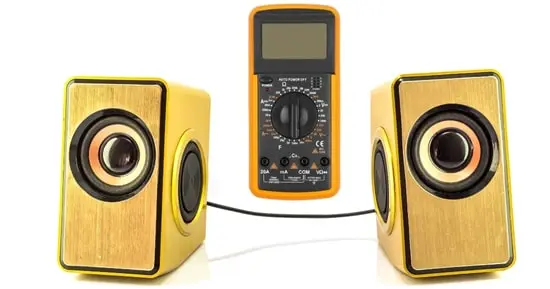This article will show you how to test the speaker ohms using a multimeter. Speakers are in great use nowadays, but if any little problem occurs, they start making trouble with their output. If you are facing the same problem, we are telling you how you can check out the trouble, which is lowering the quality of your speaker.
In this regard, the main thing you should check here is your speaker’s resistance. For checking the resistance, the best option is to use a multimeter.
It would help if you chose the multimeter because it is easy to handle and gives accurate results. But before telling you about the procedure of checking resistance through a multimeter, you should first know the precautions of the procedure.
So here we are, mentioning what to do before checking the resistance of your speaker with the multimeter.
Precautions:
- First, you should turn the speaker
- If your speaker is connected to the amplifier, then break this connection.
- It is important when you are up to check the resistance of your speaker.
- The second thing you should know here is that there are two speaker characteristics measured in Ohms.
- The first is resistance, and the second one is impedance.
- So make sure you read out the value of the resistance of your speaker, which is displayed on the backside.
- You should know this because the actual resistance value of the speaker displayed by the company will help you in the final results of the test.
Table of Contents
ToggleHow to Test Speaker Ohms with a Multimeter?
As you are now going to check the resistance of your speaker, so you have to follow the steps below.
- The very first step is to turn on your multimeter.
- The multimeter has different settings, so you have to set your multimeter on the resistance setting.
- Here you will see the positive and negative leads you have to connect with the speaker.
- Now check the resistance and compare the results by following the procedure below.
Set the multimeter
Turn on your multimeter and set the settings to the ohm symbol given there. It means that you have set the multimeter upon the option where it is ready to check the resistance of your gadget.
Join the leads
There are positive and negative leads that should become in touch with the respective terminals. Now your connection is set, and you are ready to check the resistance of your speaker.
Take the results
The resistance reading will be displayed on your multimeter’s digital screen when you touch the leads with the terminals. Here you have to note down the resulting reading carefully.
Compare the readings
- If your speaker has a resistance reading up to 4 ohms, then the normal reading of the resistance multimeter will show to you is between 2 to 3.4 ohms.
- If your speaker has the actual resistance value of 8 ohms, then the normal reading on the multimeter will be between 5 and 7.
- If the actual resistance of your speaker is 16 ohms, then the normal results of the multimeter will be between 12 and 14.
- If the results fluctuate from the above-given measurements, then it is sure that your speaker has some technical problem in it.
Types of technical issues
- If the multimeter gives you a resistance value above the normal one, it means that there is some broken connection in the speaker.
- And if the multimeter gives you a very low resistance value from the normal one, it means that there is a short somewhere inside your speaker.
- Under both conditions, you have to change your speaker because both conditions are bad.
Final verdict
The resistance is the measurement of the direct current passing from your gadget. Checking the resistance is a good option because it directly deals with the direct current, so when there is any problem in the resistance, then it means that there is some breakage or a short circuit inside your gadget.
And when you use the multimeter, it helps you find the exact reason between these two possible reasons so that you can go for the better option while buying the speaker in the future.
Related Guides:






